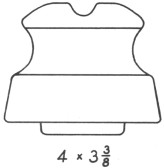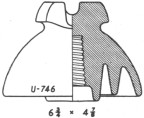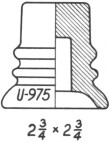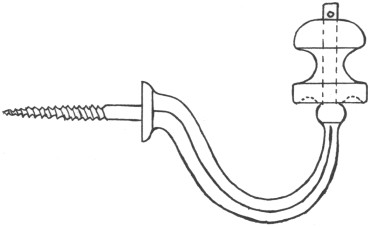Porcelain Insulator News
by Jack H. Tod, NIA #13
Reprinted from "INSULATORS - Crown Jewels of the Wire", September 1983, page 25
Caroline and I wish to join the
Crown Jewels staff and all other collectors in mourning the passing of Esta
Brown on July 10, 1983. She was a pioneer in building the foundation of the
insulator collecting hobby and leaves as many friends as there are collectors.
Following Esta's interest in glass insulators, her husband Gerald began
collecting porcelain insulators and became one of the most well-known
researchers, writers and publishers in the hobby. He has been a contributor to
this column for many years.
Jack

Dear Jack:
I came across an Interesting
porcelain insulator recently (U-776A, white glaze, underglaze Illinois map
marking), and I wondered about its usage.
Randal Wickersham
Duncanville, Texas

- - - - - - - - - -
Dear Randal:
The 44 in your marking is the Illinois catalog number for this
design, and the 1938 is the year of its manufacture.
The exact usage of this and
many other styles of pin types isn't always stated in factory catalogs. They
usually just list them bare-face and leave it up to customers to order whatever
they fancy as fitting their own application. This particular design originated
with Locke in the early 1930's and spread to other companies, and it was the
lowest voltage rating of the "Hi-Top" series and the only one of the
group meant for "side tie". Generally these insulators were billed as
secondary distribution insulators, and thus could be used in any such
application.
This insulator rates as a good collector item because of it being a
popularly desired shape, its white glaze and the nice marking.
Jack
It is with
pride and a degree of humility that I relate to you that the National Insulator
Association awarded Caroline and myself honorary Lifetime Memberships at the
annual convention and show held in Rochester., N.Y. this year. We feel deeply
honored by this award.
Unfortunately we were not in attendance at the show to
receive the beautiful metal display cards in person. Most collectors are aware
that I have not actively collected insulators for several years and that we have
only a few months between the snow drifts to enjoy our summer home in the COOL
Arizona mountains. It's no longer in the cards for us to travel to distant hobby
shows during the summer period.
Jack

Dear Jack:
I am enclosing information and
photos of a Fred M. Locke Insulator I bought in Maine a few years back.
It is a
very crude job of glaze weld and has a white glaze with a greenish tint. It
bears a partly legible underglaze marking on the skirt, probably the #6-3 with
six dates, since the readable portions agree with that one. Because of the odd
glaze, it is hard to tell if the marking was with black, green or blue ink.
I'd
like to know more about this item, especially as to its possible rarity. I've
not seen or heard of another one like it.
Richard C. Wiseman
Sterling Junction,
Mass.

- - - - - - - - -
Dear Richard:
This white Fred Locke is quite exciting, obviously rare and
of very good value. I haven't seen a Fred Locke of this style before, and it win
be a new addition to the Universal Style Chart after the preliminary drawing
(above) can be completed as to internal detail.
It's really wild. If you looked
up at this on a pole where you didn't notice the relatively small top groove,
you would swear you were staring at something Pinco or Knox had turned out in
the 1970's. Whoever designed this insulator for Fred Locke was 75 years ahead of
his time.
Jack

Dear Jack:
I have a white Imperial Porcelain Works insulator
which doesn't really fit any U- number in the Universal Style Chart. It
resembles U-935 for overall size and its general shape, but the crown is flat on
top. It has both of the wordy Imperial marking stamps plus a 6-29-99 date
stamp.
The insulator is a beauty and was removed from a power line in 1983.
Assuming it was put on a line in 1899, it has been in continuous service for 84
years.
I look forward to your column and find it one of the most informative
reference sections available in our hobby.
L. John Berard
Cache Creek, BC,
Canada
- - - - - - - - -
Dear John:
On page 32 of the Sept. 1977 CJ issue, I included a report
from George Rahier (also BC, Canada) of Imperials from a line then being
dismantled (also dated 6-29-99), but from his sketch I incorrectly tagged these
as U-935.
Later Bob Reyburn (Calif.) sent a report and nice photos of these flat-crowned Imperials (U-746) as compared to the somewhat similar U-935, and
this was all-discussed an page 17 of the April 1978 CJ issue. In essence the
1897-1898 U-935 Imperial design evolved into the U-746 version some time after
that period and was manufactured by a number of companies for quite a long
period -- being known as the "Redlands" insulator because of it having
been developed for the original Redlands., Cal. transmission line. Bob's U-746
Imperials weren't dated, but the 1899 date on yours does at last answer the
question as to when this design evolved.
Yes, if this specimen was in use those
84 years, it might set a record for power insulators. At least a few years back
I knew of other Imperial and Fred Locke insulators of similar vintage still in
use in certain California areas. If used well under their maximum voltage
ratings, and if undamaged by external factors, there shouldn't be any reason why
well made porcelain power insulators couldn't serve indefinitely. But in real
life, they are scrapped out because of being nonstandard items and of antiquated
design -- their tiny wire grooves, lack of radio treatment, etc. Most Imperials
were scrapped many years ago because of their white glaze -- super targets for
vandals' missiles.
Jack
Dear Jack:
In the May 1983 column, you asked for
attribution information on William Ogden's "Crystal Valve" lightning
arrestor.
Crystal Valve arrestors were also known as Keystone lightning
arrestors and were made by Electric Service Supplies Company ....
The type LB
(single pole) and Type LC (double pole) are rated up to 750 volts AC and are
designed for outdoor service in various applications where power is transmitted
and utilized generally at 440 to 550 volts.
They consist essentially of a
cartridge enclosed in a glazed porcelain body and provided with line and ground
leads.
Frank Donnelly
Menlo Park, Calif.
Many thanks. I knew someone out there
would have the information on this trade name.
Jack

Dear Jack:
Enclosed is
information on the new style of threadless porcelain insulator found in a dump
on a building site in Guelph, Ontario, Canada last spring. The dump also
contained a U-980 Elliot threadless and a lot of open-pontilled bottles.
Five
of these were found, four a medium dark brown and one a lighter brown. I managed
to obtain all five and have kept one of each color. The other three were sold at
the NIA annual convention show in Rochester, N.Y.
These insulators are made of a
dark gray colored clay rather than a true porcelain body material. I believe
this item to be Canadian but do not know for sure.
Dr. R. Dean Axelson
Willowdale, Ont., Canada
- - - - - - - - - - -
Dear Dean:
Many thanks for the information on this new
find of "porcelain" threadless, and it will be U-975 in the Universal
Style Chart. This could well be of Canadian origin, but we will probably never
know. Regardless of that possibility, it will be in the U.S. Chart simply to
afford it a convenient reference number. That is the whole purpose of the style
charts -- so we can all be talking about the same insulator style by merely
calling out its number.
When I first published my reference book in 1971, we
really had no concrete information on any threadless pottery or porcelain
insulators. Since then, we've found quite a few different styles of them (all
scarce or rare), and two different new ones this year alone. Maybe we're just
now getting to the right old dumps, but it could be that bottle diggers now
recognize porcelain threadless for what they are now that both glass and
porcelain insulators are such widely recognized collectibles.
Jack
Dear Jack:
... and while at Penn State University I obtained a unique bracket/insulator
from an old barn that was slated for demolition. A second one of these on the
barn was badly broken. The wires to any nearby buildings or poles were long
gone, so I couldn't determine the insulator's use.
The porcelain knobs are an
unusual shape and are retained on the malleable iron bracket with a cotter pin.
Neither the bracket or the knob has any marking.
I've never seen another like
this, even though I've been collecting since the 1960's. Do you have any ideas
as to who made it -- or when?
Steven Corfidi
Kansas City, MO

- - - - - - - - -
Dear Steven:
No, I
don't have any information an it. I'd imagine it is of early 1900's vintage, and
you could probably bet that there is an old patent on it.
I've mentioned several
times before in this column that anyone could really enjoy forming a specialized
collection of the antique insulator brackets. I've seen some real dandy ones in
past years. The insulators may get lost to the winds (you can replace those),
but the old brackets are still out there just waiting to be liberated from old
buildings and defunct pole lines. Nearly all of them were patented, and the
patents can usually be located by using the classification system of the Patent
Office.
Jack
Dear Jack:
Aside from collecting insulators, I also collected coins
at one time and was recently looking at a guide book of U.S. coins (the
"Red Book") and came across the name Jack H. Tod and wondered if that
might be you.
I also would like to know if the Victor insulator plant might have
ever made coffee cups with the VICTOR marking on the bottom.
Ken Jackson, NIA
#1888
Sweeny, Texas
- - - - - - - - - -
Dear Ken:
Yep, that was me, I've collected coins all my
life. I owned a retail coin shop and dealt nationally in the early 1960's,
specializing in Lincoln cents and becoming a recognized authority on that
series. As such, I was a contributor to publications such as the U.S. Guide Book
on coins.
The insulator plant at Victor, N.Y. did make heavy coffee mugs with a
"VICTOR" marking, but they were still doing that in very recent years,
if not to the present day. When I was there in 1972 or 1973, they were not only
cranking out the VICTOR mugs in a side room, but the whole cafeteria was
outfitted with hotel-like china that they had made, and it was all marked with
the I-T-E logo in blue.
Jack
Dear Jack:
A local utilities company is using
Japanese insulators! The foreign insulators look like American ones by their
style and color -- sky-tone with black crown.
They are marked 
I was
greatly shocked when the lineman said the company used whatever they could get
and that the foreign insulators cost less. What do you think?
Chris Umscheid,
NIA #2849
Cedar Rapids, Iowa
- - - - - - - - - - -
Dear Chris:
This is nothing new. Most companies are
much more interested in the bottom-line financial figures than they are in
waving the banner for the buy-American crusaders, sad as it is. The primary
interest of utilities in insulators is reliability, so the foreign insulators
must be good to be considered at all, regardless of their cost.
Just to be fair
to the utilities, try this test on you and your friends. Next Christmas day,
open all the several dozens of presents under your tree and see if you can find
even a single one with a "Made in U.S.A." label!
Jack
| 